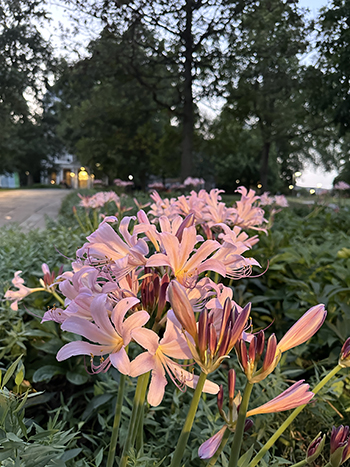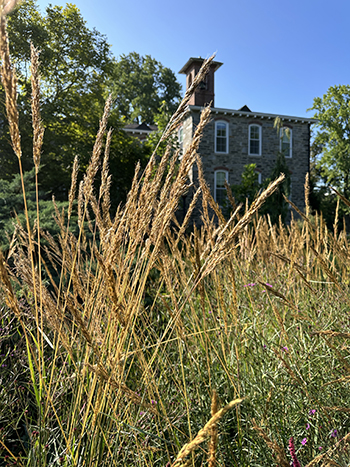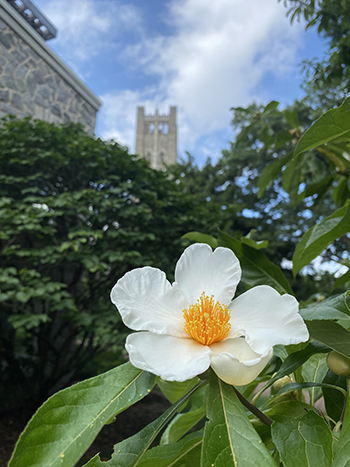
Plants of the Week: August 12
Guest Author: Patty Lally, 2024 Summer Intern

Lycoris squamigera (surprise lily)
As we come towards the end of summer, the flowers of Lycoris squamigera surprise lily have begun to pop up around campus. This perennial bulb produces 5 to 7 pale pink trumpet-like blooms atop the 2-foot tall stalks. These pale pink flowers feature a blue iridescent hue to them, making them look truly magical.
This bulb does not like to be disturbed, nor does it like to be cold. Temperatures below 28 degrees fahrenheit will injure it, so be sure to put a nice, thick layer of mulch over your planting site during the winter. Lycoris squamigera is adapted to many soil types, but prefers well drained and fertile soils, accompanied by full sun. Lycoris squamigera would be best featured among a ground cover or a flower bed, as it brings a cheerful surprise to the space. You can find Lycoris squamigera along Magill Walk.

Sorghastrum nutans ‘Golden Sunset’ (Indian grass)
I felt a bit lucky being able to witness this next plant gracefully swaying in the afternoon breeze. Sorghastrum nutans ‘Golden Sunset’, also known as Indian grass, is a warm season grass native to the southeastern United States.
It features a feathery golden plume of flowers and seed heads supported by its long, blue-green blades. I, for one, am excited to see this perennial change color once fall arrives. Its present golden color will shift into a bronze hue, and may even turn purple.
Reaching a height of up to 8 feet tall, this grass would be an excellent addition to a texture garden. Plant this beauty in full sun in just about any soil type, it’ll handle it! However, if planted in very fertile soil, it will tend to flop. Mesic conditions would be preferable, and may tolerate some erosion and pollution. You can find Sorghastrum nutans ‘Golden Sunset’ in the John W. Nason Garden.

Franklinia alatamaha (Franklin tree)
The flowers of this last plant really remind me of a sunny-side up egg. Franklinia alatamaha, also known as franklinia or Franklin tree, features cup-shaped flowers with five creamy white petals and an egg yolk center. Blooms will last from late summer until early fall. Their fragrance is similar to orange blossoms or honeysuckles, leaving a lingering summer scent, perfect for a fragrance garden.
This tree has been extinct in the wild since 1803. All current franklinia trees originate from seed collected by John Bartram, a friend of Benjamin Franklin. Franklinia alatamaha will need to be planted in full sun with some afternoon shade and pair with acidic soil and you will be good to go! You can find Franklinia alatamaha in Tree Peony Collection.





No Comments